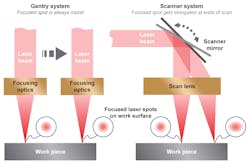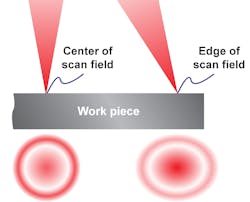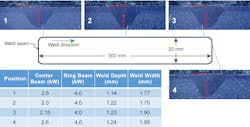Advances in laser welding prismatic battery: Can to cap
Numerous manufacturers are working to improve electric vehicle (EV) performance and economics. A major part of this effort is focused on improving battery technology; in particular, developing methods and materials to simultaneously bring down fabrication costs (especially reducing production cycle time) and also extend reliability. Can-to-cap welding of prismatic battery cells is a standout example of this work, and one in which recent developments in laser welding are addressed with great success.
Can-to-cap welding specifically refers to the process of sealing the lid on the casing (can), which contains all the electrode structures for the battery. This sealing is done after these internal parts have been assembled into the can. Since this occurs near the end of the production cycle—after most of the value has been built into the assembly—scrapping parts at this stage is particularly costly.
The sealing operation requires making a fairly long, continuous weld. A typical prismatic battery is around 20 mm wide by up to 300 mm long, and the weld goes around the entire battery perimeter. There are several key requirements for manufacturers to perform this process:
- The weld seam must provide a hermetic seal with no gaps along the entire weld—even if the original part fit-up wasn’t perfect or isn’t consistent (especially at the corners).
- Welding must achieve adequate penetration depth and low weld porosity. This is necessary to create a seal strong enough to last the lifetime of the battery without cracking open, even when subjected to vibration and mechanical shock.
- The welding process cannot create any spattered metal. Most importantly, spatter cannot occur inside the battery where it might create electrical short circuits. Spatter is especially a problem when welding aluminum, which is commonly used for battery cans. This is due to several factors, but primarily because of aluminum’s high reflectivity and low melting temperature. These may lead to keyhole instability, which causes weld spatter.
- The heat input into the battery must be limited to avoid damaging internal parts.
Fiber lasers can deliver on all these requirements. As a result, they have already established themselves as useful production tools for prismatic battery can-to-cap welding. In the most common implementation, the beam focusing optics are gantry-mounted, and then moved around to follow the shape of the desired weld seam.
This gantry approach delivers highly precise mechanical alignment and great weld consistency. This is because the laser beam always hits the workpiece at the exact right place and the same angle of incidence. However, moving the optics (or alternately, the battery) makes a gantry system slow. This is an issue because slower speed translates directly into higher production costs.
Faster way to weld large areas
As manufacturers strive to dramatically increase their production capacity and also go to larger-sized prismatic batteries, the speed limitations of gantry-type welding systems become a significant issue (see Fig. 1). It’s well known that scanning systems can deliver higher weld speeds. This is because it is much easier to move the weightless laser beam using scanner mirrors than it is to physically translate the entire focusing optics assembly.
However, scanning systems also face challenges when welding physically larger parts. There are a few reasons for this. First, the beam gets geometrically distorted as it approaches the edges of the field of view, changing from a circle to an oval. Because of the large size of these parts, this is especially problematic in the corners and ends of the cans. Second, this beam distortion can combine with the change in scan direction in the corners to produce a weld seam that doesn’t meet the customer’s quality requirements. Also, the changing beam size and angle of incidence on the part change the power density at the work surface, which affects the way it welds.
There was a way to completely compensate for all these factors until relatively recently. The solution was the introduction of fiber lasers whose spatial beam profile can be dynamically varied. This allows a welding system to compensate for the effects of geometric beam distortion at the edges of the scan field as well as for changes in scan speed during the process (such as at curves).
The Coherent embodiment of this technology is the adjustable ring-mode fiber laser (ARM). In this type of laser, the beam isn’t just the traditional single spot. Instead, it’s a traditional Gaussian distribution center spot surrounded by another concentric ring of laser light.
Most importantly, the power in the center and ring spots can be independently controlled – on very rapid timescales. Closed-loop power control enables this power modulation to be performed with accuracy and repeatability. The result is highly dynamic control over exactly how the laser energy is spatially distributed during welding.
Fiber lasers go to the edge
Used correctly, this approach allows the ARM laser to produce high-quality prismatic battery can-cap welds using a scanner system. Specifically, the power ratio of the center and ring beams are changed on the fly to make the laser consistently produce the same welding result, even where the spot gets elongated.The overall power (and power ratio) can also be varied quickly enough to correct for changes in scanner speed (see Fig. 2). This is necessary because the scanner, and therefore the speed of the laser spot on the workpiece, slows down when coming into the corner of the weld seam, and then speeds back up when coming out of the corner. The same is true when welding any feature that involves tight curves or corners.
This approach also enables weld seam width and penetration depth to be independently controlled. It eliminates the need to maintain tight tolerances on part fit-up (gap width). Lowering this tolerance reduces production costs. It also minimizes the heat-affected zone (HAZ), enables high-speed scanning (>350 mm/sec), and can cover large scan fields (see Fig. 3).Overcoming the tradeoff between speed and quality
Fiber lasers have been an enormous success story in industrial materials processing applications, displacing many other laser and non-laser technologies during the past 20 years. For most of that time, however, fiber laser manufacturers have concentrated on developing ever higher output power.
But the most demanding welding processes now coming into production to support e-mobility and lightweighting need more than just raw power and brute force. They require finesse. Specifically, this means the ability to precisely control the way laser power is distributed at the work surface—both spatially and temporally. This is necessary to successfully weld thin or heat-sensitive materials, process “difficult” materials (such as aluminum, copper, and high-strength steel), and join dissimilar materials.
ARM technology is one of the innovations that have been introduced to meet this need. It overcomes the traditional tradeoff between speed and quality for fiber laser welding of prismatic batteries. This enables scanner welding systems to offer a cost-effective, high-performance method for volume production.
About the Author
Jean-Philippe Lavoie
North America Applications Lab Manager, Coherent
Jean-Philippe Lavoie is North America applications lab manager at Coherent (Santa Clara, CA).
Marc Auger
Sales Development Manager – Automotive, Coherent
Marc Auger is sales development manager – automotive at Coherent (Santa Clara, CA).


